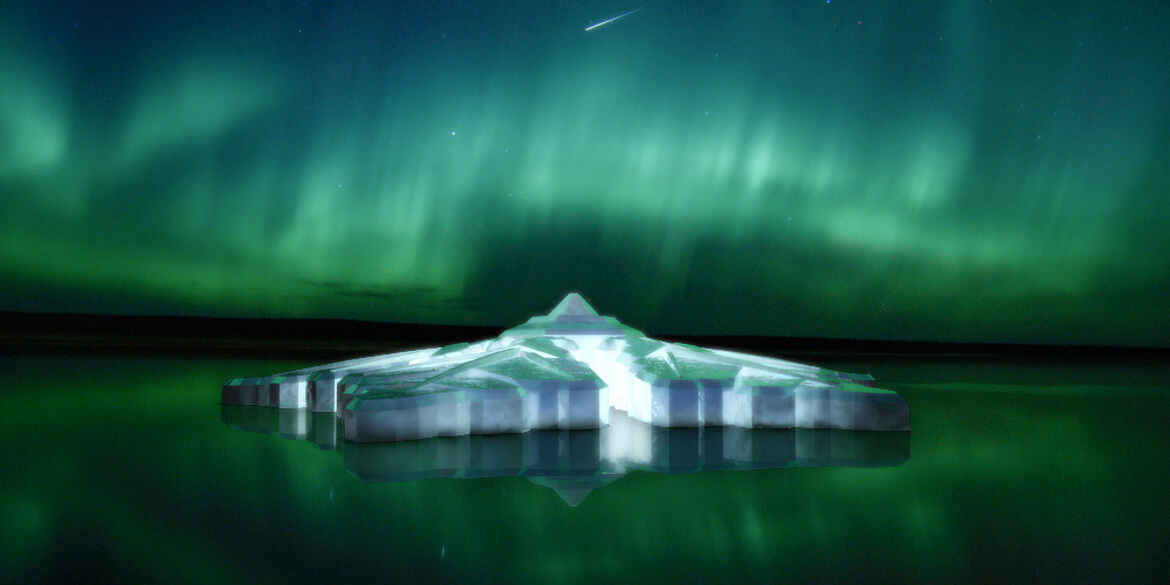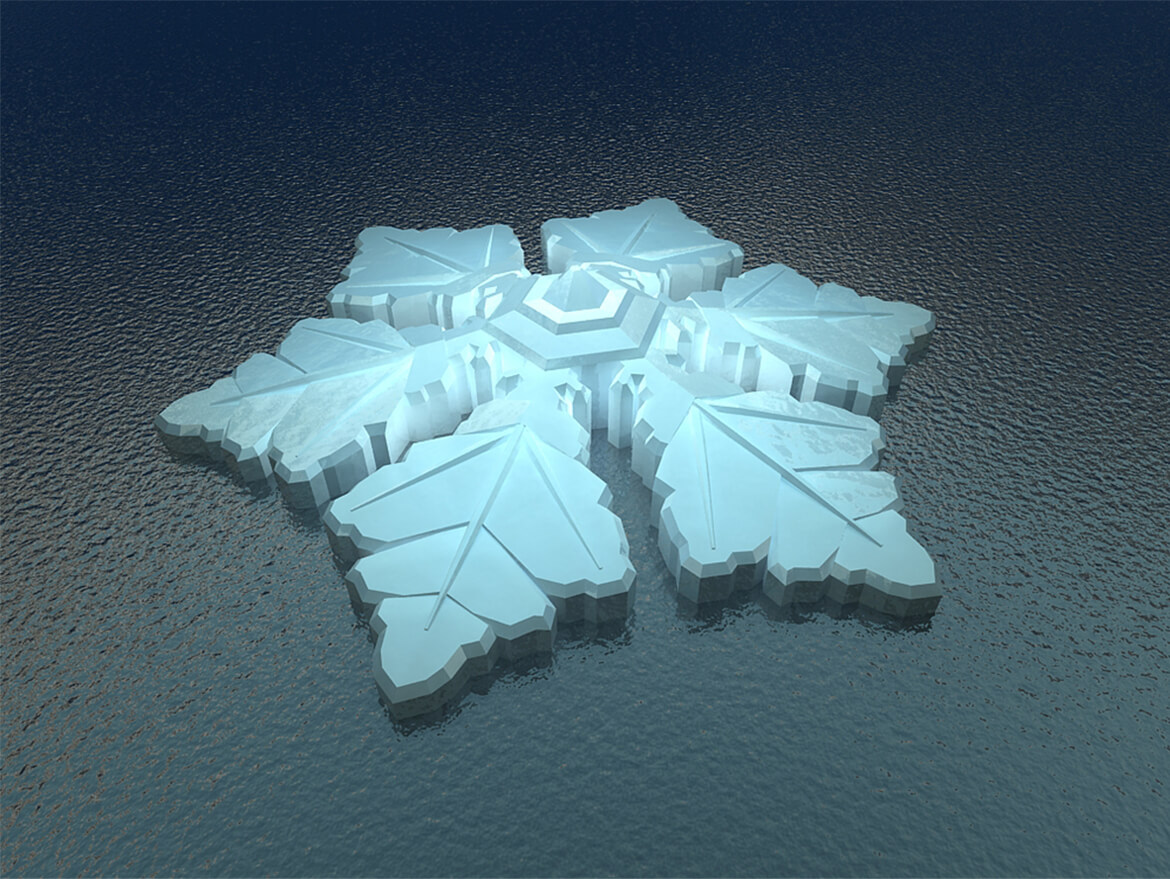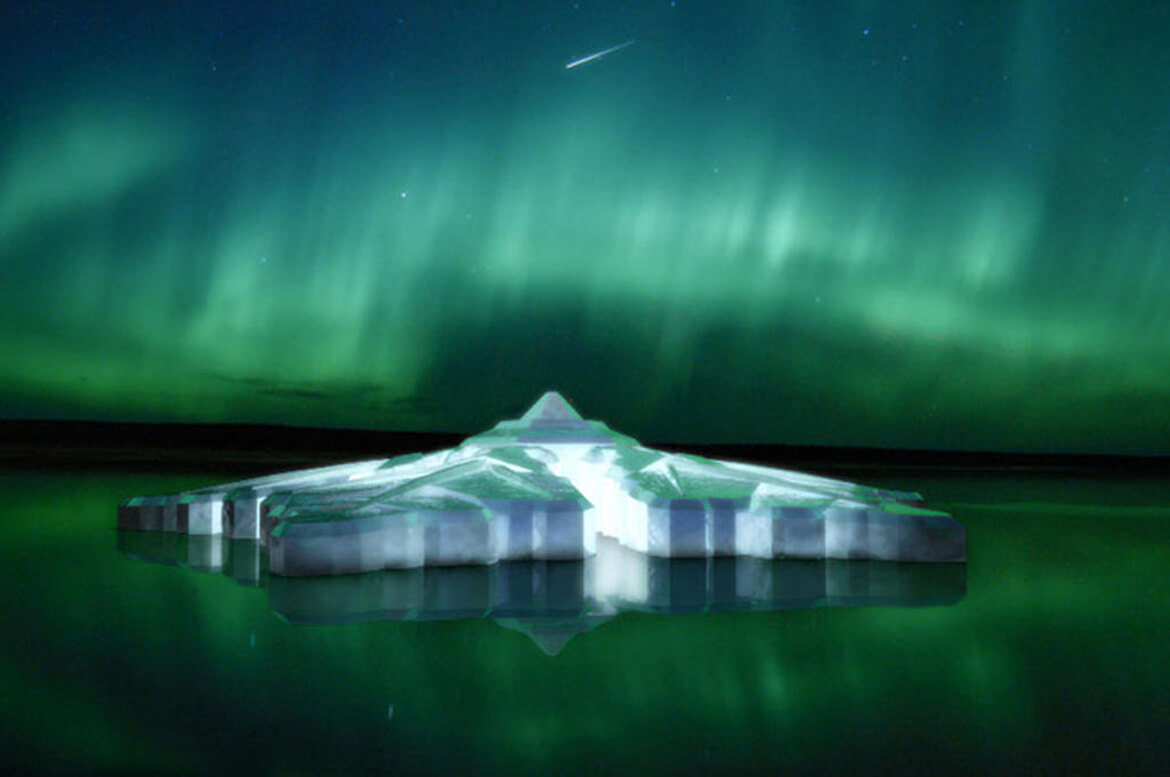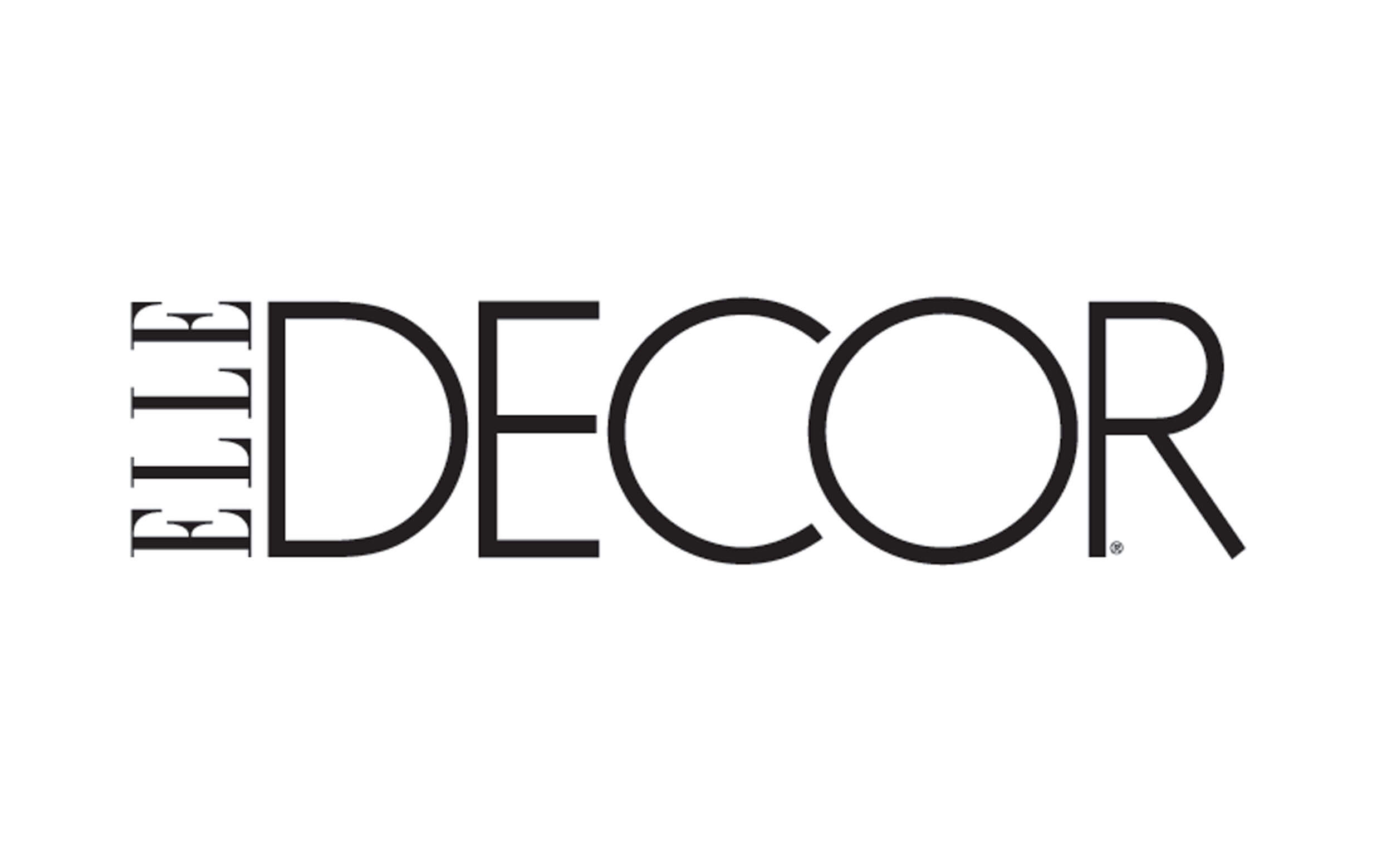Giant snowflake
By Business Spotlight
March.2015
Photo credit Waterstudio

Recently, Dutch firms have carried their control over the sea one step further, pioneering floating buildings and cities as a solution to rising sea levels. One of them is the developer Dutch Docklands, which describes itself as having ‘learned to live with the water instead of fighting it’. it works closely with the firm of architects Waterstudio, run by awardwinning architect Koen Olthuis.
“The climate change generation is no longer interested in iconic architecture, but are looking for iconic solution,” says Olthuis. “It is not the result of the individual architect that that counts, but the effect on society.” Perhaps their most futuristic work is the Krystall hotel, which will open at the end of 2016. Designed to look like a giant floating snowflake, it is being built in the icy seas near the city TromsØ in Norway. The Hotel will have glass roofs so guests can watch the Northern Lights. Its hallways will be lined with futuristic blue shapes and fireplaces will be converted in transparent blocks to look like ice.
“We call it scarless development. If you take it away after 100 years or so, it will not leave any physical foot-print,” explains Olthuis, who says that Dutch attitude is: where there is nothing, anything is possible. “The Dutch created Holland out of the sea, and that mentality is in our DNA, forcing us to be creative in situation where there seem to be no obvious solution. Some of the innovations that were born of necessity soon show potential for worldwide use.”
Stjernearkitekter vil bygge flytende luksushotell i Tromsø
By Nordnytt
August.21.2014

Tromsø kommune har i dag signert en intensjonsavtale med selskapet Dutch Docklands om å bygge et flytende hotell utenfor byen.
Avtalen betyr at kommunen stiller seg positiv til at det femstjerners luksushotellet skal bygges i Tromsø.
Det nederlandske selskapet Dutch Docklands har planer om å bruke 500 millioner kroner på luksushotellet, som skal utformes som en flytende iskrystall, og inneholde 86 rom.
– Vi planlegger å bygge det mest luksuriøse hotellet i den nordlige delen av verden. Det vil bli et unikt femstjerners hotell som vil gi gjestene en opplevelse med nordlyset, men også andre aspekter av Norge og av denne delen av verden, sier Paul van de Camp administrerende direktør i Dutch Docklands.
Selskapet er eksperter på flytende konstruksjoner, og har tidligere blant annet bygget luksushotell på Maldivene.
For pengesterke gjester
Han sier at Tromsø ble valgt på grunn av historien sin, men også på grunn av at byen allerede har utbygd infrastruktur når det kommer til turisme.
– Er det et marked for et slikt hotell?
– Det vil bli et lite hotell, men i den øvre enden av skalaen. Det betyr at romprisene vil bli høyere enn det som allerede finnes på markedet i Tromsø. Vi retter oss mot folk som er villig til å betale for et visst komfortnivå og for å få opplevelser i nordlige strøk. Det er et enormt globalt marked for dette, sier van de Camp.
Nå skal selskapet samarbeide med kommunen om å få på plass de nødvendige tillatelsen, og finne ut hvor det flytende hotellet skal ligge.
Hvor og hvordan det skal bygges er ennå ikke avklart.
– Vi ønsker vanligvis å få gjort mest mulig av dette lokalt. Vi vet at norske håndverkere er kjent for å holde en høy standard, akkurat som nederlandske. Det viktigste for oss er kvaliteten på arbeidet, og får vi dette til lokalt, så støtter vi det, sier van de Camp.
Kommunen positiv
– Vi har skrevet under på en avtale om at vi er positive til at dette hotellet kommer til Tromsø kommune for å etablere seg her. Vi kan bistå med kartmateriale, og når de har funnet fram til hvor de vil at hotellet skal ligge, så kan vi ha et oppstartsmøte, sier Britt Hege Alvarstein byråd for byutvikling i Tromsø kommune.
Hun sier at kommunen nå driver med en revidering av kommuneplanen og en kystsoneplan for Tromsø.
– Vi har ikke tatt høyde for at vi skal ha et flytende hotell i kommunen, så det må vi nå ta høyde for, sier Alvarstein.
Plan- og bygningsloven, reguleringsplaner og ikke minst skipsleden i Tromsø blir førende for hvor hotellet kan ligge, men det blir trolig i en av fjordene rundt byen.
Miljøprofil
– Selskapet har sagt at de ønsker at hotellet skal ligge rundt en times reise unna flyplassen, sier Alvarstein.
Hun peker på at selskapet bak hotellet har en miljøprofil og blant annet samarbeide med UNESCO for å ta vare på miljøet rundt og under der de bygger, så de lager minst mulig fotavtrykk i naturen.
– Det er spennende teknologi som tas i bruk, og ets pennende prosjekt på alle områder, sier Alvarstein.
– Er det ikke allerede nok hotellrom i Tromsø?
– Vi så både under sjakk-OL og Arctic Race at det ikke var rom å oppdrive, så kommunen har ennå behov for flere hotellrom. Men dette er jo et marked som kommer utenom det vanlige. Det vil være med på å forsterke det eksisterende tilbudet i byen, mener Alvarstein.
You’ll get a chilly reception! Plans revealed for floating snowflake hotel in Norway that offers the perfect view of the Northern Lights


MailOnline, Sarah Gordon, July 2014
If you want to get the best view of Aurora Borealis, it is best to be as far away from light pollution as possible.
So this new floating hotel could be the perfect answer for holidaymakers who want to spend their evenings looking skyward for a glimpse of the glorious Northern Lights.
Rather appropriately, the new luxury hotel will be shaped like a snowflake and will be based in the fjords near the Norwegian town of Tromso, which sits within the Arctic Circle – one of the best places to spot the celestial phenomenon.
Known as the Krystall hotel, the unusual property is being developed by company Dutch Docklands, which specialises in floating structures and will be the first floating hotel in Europe.
Work will begin next year and the 86-room hotel should be ready to open to visitors in 2017.
The five-star offering will boast a spa and wellness centre and is designed to be completely self-supporting and self-sustainable.
Dutch Docklands explained: ‘The design is based on an ice crystal which blends-in naturally with the “winter environment” between the most beautiful fjords.’
The property will be built on a concrete base and will be tethered to the fjords, but will still be free to move between six and 10 feet either side of its epicentre.
However, guests should be unaware of the small changes in position, according to the designers.
The hotel has been branded a ‘scarless development’ by Waterstudio, a design company working alongside Dutch Docklands, as it will have minimal impact on its surroundings and could be removed in the future without any problem.
It has not been confirmed how much it will cost to develop the hotel, but Koen Olthius from Waterstudio said it is likely to be 15 per cent more than building a normal hotel, due to the floating foundation.
Dutch Docklands is also planning to open another floating property in the Maldives, called Ocean Flower.
And Italian designer Michele Puzzolante has proposed the development of another floating hotel in the Maldives and there are plans afoot to build an entire city that sits on the surface of the water, including museums and a theme park in China.
Northern Lights watch from the floating snowflake hotel
Koen Olthuis’s Floating Krystall Hotel to Sparkle off the Coast of Norway


Inhabitat, Beverley Mitchell, August 2014
Koen Olthuis and Dutch Docklands have announced a new project: a five-star floating hotel off the coast of Norway named the Krystall. Reminiscent of their Maldives development the Greenstar, this cold-climate sister project will take the form of a six-pointed ice crystal. As with Dutch Docklands’ other floating structures the development will be low-impact, and it’s designed to “blend in with the ‘winter environment’ between the most beautiful fjords.”
The Krystall will float offshore from the northern city of Tromso, located within the Arctic Circle. Designed to be completely self-supporting and self-sustainable, the hotel will have a diameter of 120 meters, and facilities will include 86 guest rooms, conference rooms, and spa and wellness facilities. It’s also billed as a perfect spot for viewing the Northern Lights due to its glass roof.
The five-star luxury and spectacular nature of the project is aimed at attracting wealthy visitors from Japan, Russia and Europe. As Olthuis told CNN, “In the hotel, you’ll float through hallways lined with cool, futuristic blue shapes, recline by a fireplace faced in transparent bricks resembling ice blocks and sleep in rooms tricked out in minimalist, winter-themed designs.” But true to Olthuis’s green principles, the design is not just about the aesthetics. To be built in dry dock and then positioned in place, the hotel will not leave a lasting footprint on its location. “That’s the only way to bring a hotel to such a precious and beautiful marine environment,” he says.
Floating structures are a pragmatic design concern for the development company, as they ameliorate the risks to coastal properties associated with rising sea levels. As Olthuis explains, “We live in a dynamic world where static buildings do not bring us the needed flexibility. Building on water brings us new space for expansion, safety against floods and flexibility to adjust developments without demolition whenever needed.” The hotel is set to open in December 2016.










